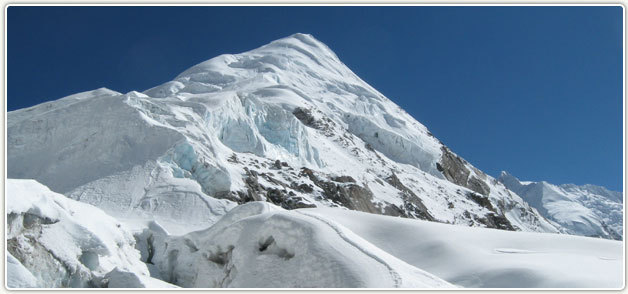Nepal Govt. Registered No : 87304
Nepal » Peak Climbing in Nepal
The Nepal Mountaineering Association (NMA) has categorized the mountains of Nepal into various classifications, one of these being called trekking peak or Group B Climbing Peak as per the NMA. A trekking peak is a mountain under 7000 meters that is considered climbable by anyone with a moderate amount of mountaineering experience and skills. While some can be climbed without crampons or an ice axe, most require use of this equipment. In order to attempt a trekking peak, a climbing permit (non-refundable) must be obtained from the NMA in Kathmandu.
NMA Peaks
Group "A" NMA Peaks
01. Mt. Cholatse 6440 m.
02. Mt. Machermo 6237 m.
03. Mt. Kyazo Ri 6186 m.
04. Mt. Nirekha 6186 m.
05. Mt. Langsisa Ri 6427 m.
06. Mt. Ombigaichen 6340 m.
07. Mt. Bokta 6143 m.
08. Mt. Chekijo 6257 m.
09. Mt. Phari Lapcha 6017 m.
10. Mt. Lobuche West 6145 m.
11. Mt. Larkya Peak 6249 m.
12. Mt. ABI 6097 m.
13. Mt. Yubra Himal 6035 m.
14. Mt. Yala 5732 m.
15. Mt. Chhukung Ri 5550 m.
Group ‘A’
1-7 Members US$ 500 + US$ 100 for each additional climber up to 12 person.
Garbage Deposit US$ 250
Group "B" NMA Peaks
1. Shigu Chuli(fluted peak) 6501 m.
2. Mera Peak 6654 m.
3. Kusum Kangru 6367 m.
4. Kwandge 6011 m.
5. Chulu West 6419 m.
6. Imja-tse(Island Peak) 6189 m.
7. Pharchamo 6187 m.
8. Lobuche 6119 m.
9. Ramdung 5925 m.
10. Pisang 6091 m.
11. Tharpu Chuli (Tent Peak) 5663 m.
12. Khongma-tse(Mehara Peak) 5849 m.
13. Ganja-la Chuli(Naya Kanga) 5844 m.
14. Pokhalde 5806 m.
15. Mardi Himal 5587 m.
16. Paldor 5896 m.
17. Hiunchuli 6441 m.
18. Chulu East 6584 m.
Group ‘B’
1-4 climbers US$ 350 + US$ 40 for each additional climber up to 8 persons.
9 climbers US$ 535 + US$ 25 for each additional climber up to 12 person.
Garbage Deposit US$ 250
Note: Maximum number of members in team is 12.
1) Island Peak known as Imja Tse is a mountain in the Himalayas of eastern Nepal. The peak was named Island Peak in 1951 by Eric Shipton's party since it appears as an island in a sea of ice when viewed from Dingboche. The peak was later renamed in 1983 to Imja Tse but Island Peak remains the popular choice. The peak is actually an extension of the ridge coming down off the south end of Lhotse Shar.
Island Peak was first climbed in 1953 by a British team as a training exercise in preparation for Mount Everest. Island Peak is one of the most popular trekking peaks given its difficulty and accessibility especially when supported by a Nepalese climbing guide.










